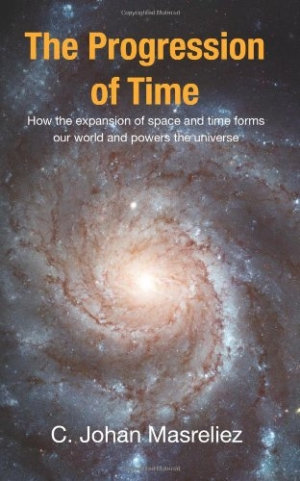The Progression of Time
How Expanding Space and Time Forms Our World and Powers the Universe
According to C. John Masreliez, the inability of the concept of general relativity to account for the progression of time indicates that something is missing in the esteemed theory. Masreliez’s independent research led to the development of a model of the cosmos—what he calls the Scale Expanding Cosmos model—that demands a revision of known physics to accommodate a dynamic spacetime scale. In his willingness to accept the possibility that most of our current “knowledge” of the cosmos is wrong and based on faulty science, Masreliez opens the door to a new world, one that “will seem as magical to us as our present world would have seemed to people a few hundred years ago.”
Masreliez holds a Master of Science degree from the Royal Institute of Technology in Stockholm and a PhD from the University of Washington’s Electrical Engineering Department. He has been conducting independent research to develop the Scale Expanding Cosmos model since 1993 and has published a number of papers and essays on this and related subjects, including the origin of inertial force and the link between general relativity and quantum mechanics. The Progression of Time is a summary of his findings.
General relativity, states Masreliez, leaves a number of inconsistencies unresolved: the progression of time, for which no scientific explanation currently exists; the origin of the universe; whether or not dark matter and dark energy exist; accelerating cosmological expansion; the incompatibility of general relativity with quantum theory; whether the wave functions posited in quantum theory are real physical waves or not; the particle-wave duality; the possibility of action at a distance faster than the speed of light; and the origin of inertia.
Masreliez decries the tendency of scientists to ignore inconsistencies that call accepted beliefs, including the big bang theory, into question. He believes that building upon what is known while remaining skeptical of previous knowledge will allow for the development of theories that both agree with observations and are internally consistent.
One does not have to be a scientist to follow Masreliez’s compelling logic. He has taken a difficult topic and made it accessible and appealing to laypeople with an interest in cosmology and physics, and he has kindly placed most of his supporting equations, which only someone at his own level of expertise would understand, in the appendices at the end of the book.
Careful proofreading would correct the infrequent typographical and grammatical errors and omissions. Since errors exist in the text, it would be advisable that the equations also be checked for accuracy. The cover design and layout are excellent, and the cover art is not only appropriate, but attractive and powerful.
Masreliez’s text is an exciting and mind-opening introduction to a new and dynamic theory that not only claims to reconcile the above-noted inconsistencies, but offers a whole new way of thinking about the workings of the universe.
Reviewed by
Kristine Morris
Disclosure: This article is not an endorsement, but a review. The publisher of this book provided free copies of the book and paid a small fee to have their book reviewed by a professional reviewer. Foreword Reviews and Clarion Reviews make no guarantee that the publisher will receive a positive review. Foreword Magazine, Inc. is disclosing this in accordance with the Federal Trade Commission’s 16 CFR, Part 255.

